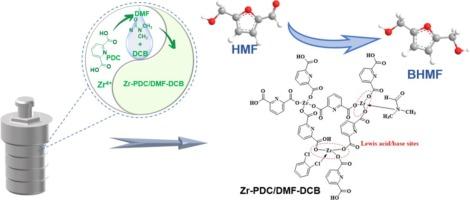用于催化 5-羟甲基糠醛转移加氢的高效 Zr 基配位聚合物:调节酸强度并提高稳定性
IF 6.7
1区 工程技术
Q2 ENERGY & FUELS
引用次数: 0
摘要
本研究通过溶热法合成了 Zr 基配位聚合物,用于生物质衍生醛酮的 Meerwein-Ponndorf-Verley 还原反应。在催化剂制备过程中,可通过使用不同的溶剂来调整路易斯酸位点的形态和强度。以吡啶-2,6-二羧酸(PDC)为配体,在 N,N-二甲基甲酰胺(DMF)和 1,2-二氯苯异丙醇(DCB)混合溶剂中合成的 Zr-PDC/DMF-DCB,在 100 ℃ 下可获得 98.5 % 的 2,5-双(羟甲基)呋喃(BHMF)产率,并表现出中等的路易斯酸位点。相反,在醇类(Zr-PDC/MeOH 和 Zr-PDC/EtOH)中合成的 Zr-PDC 用作催化剂时,形成的是醚化产物而不是 BHMF。对催化剂制备过程中溶剂作用的进一步研究表明,Zr 位点与 DMF 之间的配位增加了 Zr 位点的电子云密度,从而削弱了路易斯酸性。此外,疏水性 DCB 的加入导致了球形形态的形成,从而提高了抗碳沉积能力并增强了抗团聚性能。这项研究提出了一种控制配位聚合物酸强度和提高催化稳定性的策略。本文章由计算机程序翻译,如有差异,请以英文原文为准。

Highly efficient Zr-based coordination polymer for catalytic transfer hydrogenation of 5-hydroxymethylfurfural: Tuning acid strength and enhancing stability
In this study, Zr-based coordination polymers were synthesized via solvothermal method for the Meerwein-Ponndorf-Verley reduction of biomass-derived aldehydes and ketones. The morphology and strength of Lewis acid sites could be tuned by using different solvent during catalyst preparation. A 98.5 % yield of 2,5-bis(hydroxymethyl)furan (BHMF) was achieved at 100 °C using Zr-PDC/DMF-DCB, which was synthesized with pyridine-2,6-dicarboxylic acid (PDC) as ligand in a mixed solvent of N, N-dimethylformamide (DMF) and 1,2-dichlorobenzeneisopropanol (DCB) and exhibited moderate Lewis acid sites. Conversely, while Zr-PDC synthesized in alcohols (Zr-PDC/MeOH and Zr-PDC/EtOH) were used as catalysts, etherification products formed instead of BHMF. Further investigation into the role of solvents during catalyst preparation revealed that coordination between Zr sites and DMF increased the electron cloud density of Zr sites, thus weakening Lewis acidity. In addition, the inclusion of hydrophobic DCB resulted in the formation of spherical morphology, which improved resistance to carbon deposition and enhanced anti-agglomeration properties. This work presents a strategy for controlling acid strength and improving catalytic stability of coordination polymers.
求助全文
通过发布文献求助,成功后即可免费获取论文全文。
去求助
来源期刊

Fuel
工程技术-工程:化工
CiteScore
12.80
自引率
20.30%
发文量
3506
审稿时长
64 days
期刊介绍:
The exploration of energy sources remains a critical matter of study. For the past nine decades, fuel has consistently held the forefront in primary research efforts within the field of energy science. This area of investigation encompasses a wide range of subjects, with a particular emphasis on emerging concerns like environmental factors and pollution.
 求助内容:
求助内容: 应助结果提醒方式:
应助结果提醒方式:


